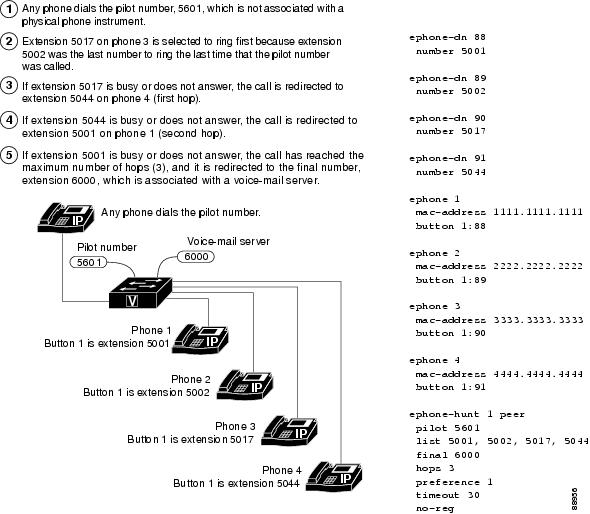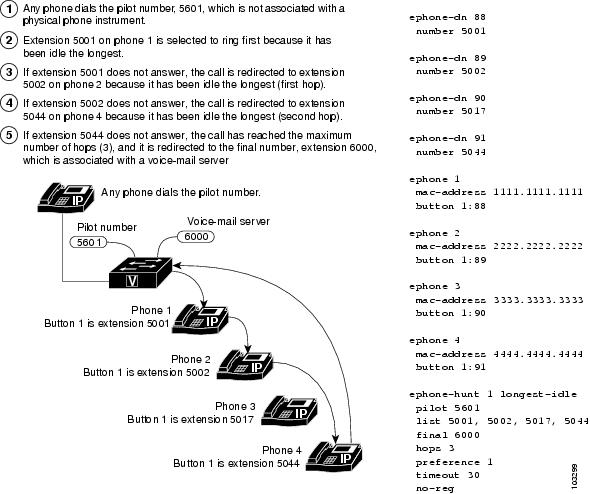Various Types of Hunt Groups
* Sequential Hunt Groups
* Peer Hunt Groups
* Longest-Idle Hunt Groups
* Parallel Hunt Groups (Call Blast)
Sequential Hunt Groups
In a sequential hunt group, extensions always ring in the order in which they are listed, left to right, when the hunt group is defined. The first number in the list is always the first number to be tried when the pilot number is called. Maximum number of hops is not a configurable parameter for sequential hunt groups.

Peer Hunt Groups
In a peer hunt group, extensions ring in a round-robin order. The first extension to ring is the number in the list to the right of the last extension to ring when the pilot number was last called. Ringing proceeds in a circular manner, left to right, for the number of hops specified when the hunt group was defined.
Below figure llustrates a peer hunt group.

Longest-Idle Hunt Groups
In a longest-idle hunt group, the algorithm for choosing the next extension to receive a call is based on a comparison of on-hook time stamps. The extension with the smallest on-hook time stamp value is chosen when the next call comes to the hunt group.
The default behavior is that an on-hook time stamp value for an extension is updated only when the agent answers a call. In Cisco Unified CME 4.0 and later versions, you can specify that an on-hook time stamp is updated when a call rings an extension and also when a call is answered by an agent.
Below Figure illustrates a longest-idle hunt group.

Parallel Hunt Groups (Call Blast)
In a parallel hunt group, calls simultaneously ring multiple phones. Using parallel hunt groups is also referred to as application-level forking because it enables the forking of a call to multiple destinations. In versions earlier than Cisco Unified CME 4.3, only SIP phones support parallel hunt groups. In Cisco Unified CME 4.3 and later versions, SCCP phones also support voice hunt groups.
You can enable functionality similar to parallel hunt groups on SCCP phones by using the ephone-dn overlay feature for shared lines.
In the following parallel hunt group example, when callers dial extension 1000, extension 1001, 1002, and so on ring simultaneously. The first extension to answer is connected. If none of the extensions answers, the call is forwarded to extension 2000, which is the number for the voice-mail service.
voice hunt-group 4 parallel
pilot 1000
list 1001, 1002, 1003, 1004
final 2000
timeout 20
The number of ringing calls that a parallel hunt group can support depends on whether call-waiting is enabled on the SIP phones.
If call-waiting is enabled (the default), parallel hunt groups support multiple calls up to the limit of call-waiting calls supported by a particular SIP phone model. You may not want to use unlimited call-waiting, however, with parallel hunt-groups if agents do not want a large number of waiting calls when they are already handling a call.
If call waiting is disabled, parallel hunt groups support only one call at a time in the ringing state. After a call is answered (by one of the phones in the hunt group), a second call is allowed. The second and subsequent calls ring only the idle phones in the hunt group, and bypass the busy phone that answered the first call (because this phone is connected to the first call). After the second call is answered, a third call is allowed, and so on until all the phones in the parallel hunt group are busy. The hunt group does not accept further calls until at least one phone returns to the idle/on-hook state.
When two or more phones within the same parallel hunt group attempt to answer the same call, only one phone can connect to the call. Phones that fail to connect must return to the on-hook state before they can receive subsequent calls. Calls that arrive before a phone is placed on-hook are not presented to the phone. For example, if a second call arrives after Phone 1 has answered the original call, but before Phone 2 goes back on-hook, the second call bypasses Phone 2 (because it is offhook).
When a phone returns to the idle/on-hook state, it does not automatically re-synchronize to the next call waiting to be answered. For example, in the previous scenario, if the second call is still ringing Phone 3 when Phone 2 goes on-hook, Phone 2 does not ring because it was offhook when the second call arrived.
Thanks & Regards
Avinash PillaiURL : http://avinashpillai.blogspot.com
Email: avinashp25[AT]gmail[DOT]com
Comments